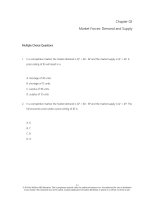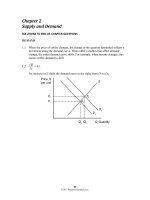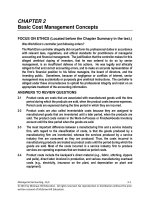Managerial economics and business strategy 9th edition by baye prince solution manual
Bạn đang xem bản rút gọn của tài liệu. Xem và tải ngay bản đầy đủ của tài liệu tại đây (2.45 MB, 73 trang )
Managerial Economics & Business Strategy 9th edition by Michael R.
Baye, Jeffrey T. Prince Solution Manual
Link full download: />
Chapter 2: Market Forces: Demand and Supply
Answers to Questions and Problems
1.
a. Since X is a normal good, a decrease in income will lead to a decrease in the
demand for X (the demand curve for X will shift to the left).
b. Since Y is an inferior good, an increase in income will lead to a decrease in the
demand for good Y (the demand curve for Y will shift to the left).
c. Since goods X and Y are substitutes, an increase in the price of good Y will lead to an
increase in the demand for good X (the demand curve for X will shift to the right).
d. No. The term “inferior good” does not mean “inferior quality,” it simply means that
income and consumption are inversely related.
2.
a. The supply of good X will increase (shift to the right).
b. The supply of good X will decrease. More specifically, the supply curve will shift
vertically up by exactly $3 at each level of output.
c. The supply of good X will decrease. More specifically, the supply curve will rotate
counter-clockwise.
d. The supply curve for good X will increase (shift to the right).
3.
a. 𝑄𝑥𝑠 = −30 + 2(600) − 4(60) = 930 units.
b. Notice that although 𝑄𝑥𝑠 = −30 + 2(80) − 4(60) = −110, negative output is
impossible. Thus, quantity supplied is zero.
c. To find the supply function, insert Pz = 60 into the supply equation to obtain 𝑄𝑥𝑠 =
−30 + 2𝑃𝑥 − 4(60) = −270 + 2𝑃𝑥. Thus, the supply equation is 𝑄𝑥𝑠 = −270 + 2𝑃𝑥.
To obtain the inverse supply equation, simply solve this equation for Px to obtain
1
© 2017 by McGraw-Hill Education. This is proprietary material solely for authorized instructor use. Not authorized for sale or distribution in any
manner. This document may not be copied, scanned, duplicated, forwarded, distributed, or posted on a website, in whole or part.
𝑃𝑥 = 135 + 0.5𝑄𝑥𝑠. The inverse supply function is graphed in the figure below.
$500
$400
$300
$200
$100
$0
0
100
200
300
400
500
Quantity of X
4.
a. Good Y is a complement for X, while good Z is a substitute for X.
b. X is a normal good.
c. 𝑄𝑥𝑑 = 6,000 − ($5,230) − $6,500 + 9($100) +
($70,000) = 4,785
d. For the given income and prices of other goods, the demand function for good X is
𝑄𝑥𝑑 = 6,000 − 12 𝑃𝑥 − $6,500 + 9($100) +
($70,000) which simplifies to 𝑄𝑥𝑑 =
1
7,400 − 2 𝑃𝑥. To find the inverse demand equation, solve for price to obtain 𝑃𝑥 =
14,800 − 2𝑄𝑥𝑑. The demand function is graphed in the figure below.
$16,000
$14,000
$12,000
$10,000
$8,000
$6,000
$4,000
$2,000
$0
0
1000
2000
3000
4000
5000
6000
7000
Quantity of X
5.
a. Solve the demand function for Px to obtain the following inverse demand function:
1 𝑑.
𝑃𝑥 = 150 − 2 𝑄𝑥
2
© 2017 by McGraw-Hill Education. This is proprietary material solely for authorized instructor use. Not authorized for sale or distribution in any
manner. This document may not be copied, scanned, duplicated, forwarded, distributed, or posted on a website, in whole or part.
b. Notice that when Px = $45, 𝑄𝑥𝑑 = 300 − 2(45) = 210 units. Also, from part a, we
know the vertical intercept of the inverse demand equation is 150. Thus, consumer
surplus is $11,025 (computed as (0.5)($150-$45)210 = $11,025).
c. When price decreases to $30, quantity demanded increases to 240 units, so consumer
surplus increases to $14,400 (computed as (0.5)($150-$30)240 = $14,400).
d. So long as the law of demand holds, a decrease in price leads to an increase in
consumer surplus, and vice versa. In general, there is an inverse relationship
between the price of a product and consumer surplus.
6.
a. Equating quantity supplied and quantity demanded yields the equation 60 - P = P 20. Solving for P yields the equilibrium price of $40 per unit. Plugging
this into the
demand equation yields the equilibrium quantity of 20 units
(since quantity demanded
at the equilibrium price is 𝑄𝑑 = 60 − (40) = 20.
b. A price floor of $50 is effective since it is above the equilibrium price of $40. As a
result, quantity demanded will fall to 10 units (𝑄𝑑 = 60 − 50), while quantity
supplied will increase to 30 units (𝑄𝑠 = 50 − 20). That is, firms produce 30 units but
consumers are willing and able to purchase only 10 units. Therefore, at a price
floor of $50, 10 units will be exchanged. Since Qd < Qs there is a surplus amounting
to 30-10 = 20 units.
c. A price ceiling of $32 per unit is effective since it is below the equilibrium price of
$40 per unit. As a result, quantity demanded will increase to 28 units (𝑄𝑑 = 60 −
32 = 28), while quantity supplied will decrease to 12 units (𝑄𝑠 = 32 − 20 = 12).
That is, while firms are willing to produce only 12 units consumers want to buy 28
units at the ceiling price. Therefore, at the price ceiling of $32, only 12 units will be
available to purchase. Since Qd > Qs, there is a shortage amounting to 28-12 = 16
units. Since only 12 units are available at a price of $32, the full economic price is
the price such that quantity demanded equals the 12 available units: 12 = 60 – PF.
Solving yields the full economic price of $48.
7.
a. Equate quantity demanded and quantity supplied to obtain 14 − 12 𝑃𝑥 = 14 𝑃𝑥 − 1.
equilibrium
is
Solve this equation for Px to obtain the equilibrium price of Px = 20. The
quantity is 4 units (since at the equilibrium price quantity demanded
𝑄𝑑 = 14 − (20) = 4). The equilibrium is shown in the figure below.
3
© 2017 by McGraw-Hill Education. This is proprietary material solely for authorized instructor use. Not authorized for sale or distribution in any
manner. This document may not be copied, scanned, duplicated, forwarded, distributed, or posted on a website, in whole or part.
$30
Supply
$25
$20
$15
Demand
$10
$5
$0
0
1
2
3
4
5
6
Quantity of X
b. A $12 excise tax shifts the supply curve up by the amount of the tax. Mathematically,
this means that the intercept of the inverse supply function increases by $12.
Before the tax, the inverse supply function is 𝑃 = 4 + 4𝑄𝑠. After the tax the
inverse supply function is 𝑃 = 16 + 4𝑄𝑠, and the after tax supply function
(obtained by solving for Qs in terms of P) is given by 𝑄𝑠 = 1 𝑃 − 4. Equating 4
quantity demanded to after-tax quantity supplied yields 14 − 𝑃 = 𝑃 − 4.
Solving for P yields the new equilibrium price of $24. Plugging this into the
demand equation yields the new equilibrium quantity, which is 2 units.
c. Since two units are sold after the tax and the tax rate is $12 per unit, total tax revenue
is $24.
8.
a. The shortage is 3 units (since at a price of $6, Q Qd
units). The full
4
1
2.5
1
1.5 units.
3
economic price is $12.
b. The surplus is 1.5 units (since at a price of $12, Q Qs
The cost to
s
d
the government is $18 (computed as ($12)(1.5) = $18).
c. The excise tax shifts supply vertically by $6. Thus, the new supply curve is S1 and the
equilibrium price increases to $12. The price paid by consumers is $12 per unit, while the
amount received by producers is this $12 minus the per unit tax. Thus, producers receive $6
per unit. After the tax, the equilibrium quantity sold is 1 unit.
d. At the equilibrium price of $10, consumer surplus is .5 $14
surplus is 0.5 $10
$2 2
$10 2
$4 . Producer
$8 .
e. No. At a price of $2 no output is produced.
4
© 2017 by McGraw-Hill Education. This is proprietary material solely for authorized instructor use. Not authorized for sale or distribution in any
manner. This document may not be copied, scanned, duplicated, forwarded, distributed, or posted on a website, in whole or part.
9.
a. The inverse supply curve is 𝑃 = 26 + 0.05𝑄.
b. When Qx = 400, producer surplus is (46 – 26) × 400/2 = $4,000. When Qx = 1,200,
producer surplus is (86 – 26) × 1,200/2 = $36,000.
10.
a. At a price of $40, consumers will demand 12 units and produce 24 units, resulting
in a surplus of 12 units. The cost of purchasing the surplus is $40 × (24 – 12) = $480.
b. Because the government purchases and discards the surplus, there are two parts to the
deadweight loss generated by the price floor. The first component is common to all
price floors (i.e. the blue triangle in Figure 2-12). We compute the first component
here as 0.5 × (40 – 28) × (20 – 12) = $48. We compute the second component as
$480 – 0.5 × (40 – 28) × (24 – 12) = $408. Thus, deadweight loss is $48 + $408 =
$456.
11.
Rising input prices that increase production costs will lead to a leftward shift in the
supply curve for RAM chips, resulting in a higher equilibrium price of RAM chips. If
in addition, income falls, the demand for RAM chips will decrease since they are a
normal good. This decrease in demand would tend to decrease the price of RAM
chips. The ultimate effect of both of these changes in supply and demand on the
equilibrium price of RAM chips is indeterminate. Depending on the relative
magnitude of the decreases in supply and demand, the price you will pay for chips
may rise or fall.
12.
The tariff reduces the supply of raw sugar, resulting in a higher equilibrium price of
sugar. Since sugar is an input in making generic soft drinks, this increase in input
prices will decrease the supply of generic soft drinks (putting upward pressure on the
price of generic soft drinks and tend to reduce quantity). Coke and Pepsi’s advertising
campaign will decrease the demand for generic soft drinks (putting downward
pressure on the price of generic soft drinks and further reducing the quantity). For
these reasons, the equilibrium quantity of generic soft drinks sold will decrease.
However, the equilibrium price may rise or fall, depending on the relative magnitude
of the shifts in demand and supply.
13.
Disagree. This confuses a change in demand with a change in quantity demanded.
Higher cigarette prices will not reduce (shift to the left) the demand for cigarettes.
14.
To find the equilibrium price and quantity, equate quantity demanded and quantity
supplied to obtain 210 – 1.5P = 2.5P – 150. Solving yields the new equilibrium price
of $90 per pint. The equilibrium quantity is 75 units (since Qd = 210 – 1.5 × 90 = 75
5
© 2017 by McGraw-Hill Education. This is proprietary material solely for authorized instructor use. Not authorized for sale or distribution in any
manner. This document may not be copied, scanned, duplicated, forwarded, distributed, or posted on a website, in whole or part.
units at that price). Consumer surplus is ($140 − $90) × 75 = $1,875. Producer
surplus is ($90 − $60) × 75 = $1,125. See the figure below.
160
140
120
Supply
Consumer Surplus
100
80Producer Surplus
Demand
60
40
20
0
0
20
40
60
80
100
Quantity
15.
This decline represents a leftward shift in the supply curve for oil, and will result in
an increase in the equilibrium price of crude oil. Since oil is an input in producing
gasoline, this will decrease the supply of gasoline, resulting in a higher equilibrium
price of gasoline and a lower equilibrium quantity. Furthermore, the higher price of
gasoline will increase the demand for substitutes, such as small cars. The equilibrium
price of small cars is likely to increase, as is the equilibrium quantity of small cars.
16.
Equating the initial quantity demanded and quantity supplied gives the equation:
300 – 4P = 3P – 120. Solving for price, we see that the initial equilibrium price is $60
per month. When the tax rate is reduced, equilibrium is determined by the following
equation: 300 – 4P = 3.2P - 120. Solving, we see that the new equilibrium price is
about $58.33 per month. In other words, a typical subscriber would save about $1.67
(the difference between $60.00 and $58.33).
17.
Dry beans and rice are probably inferior goods. If so, an increase in income shifts
demand for these goods to the left, resulting in a lower equilibrium price. Therefore,
G.R. Dry Foods will likely have to sell its products at a lower price.
18.
The figure below illustrates the relevant situation. The equilibrium price is $3.00, but
the ceiling price is $1.25. Notice that, given the shortage of 14 million transactions
caused by the ceiling price of $1.25, the average consumer spends an extra 14
minutes traveling to another ATM machine. Since the opportunity cost of time is $24
per hour, the non-pecuniary price of an ATM transaction is $5.60 (the $24 per hour
6
© 2017 by McGraw-Hill Education. This is proprietary material solely for authorized instructor use. Not authorized for sale or distribution in any
manner. This document may not be copied, scanned, duplicated, forwarded, distributed, or posted on a website, in whole or part.
wage times the fractional hour, 14/60, spent searching for another machine). Thus, the
full economic price under the price ceiling is $6.85 per transaction.
ATM Fee
Supply
$6.85
$3.00
Ceiling
Price
$1.25
Shortage =
12 million
5
Demand
19
Quantity (Millions of Transactions)
19.
The unusually cold temperatures have caused a decrease in the supply of grapes used
to produce Chilean wine, resulting in higher prices. These grapes are an input in
making wine, so the supply of Chilean wine decreases and its price increases. Since
California and Chilean wines are substitutes, an increase in the price of Chilean wine
will increase the demand for Californian wines causing an increase in both the price
and quantity of Californian wines.
20.
Substituting Pdesktop = 980 into the demand equation yields 𝑄𝑚𝑒𝑚𝑜𝑟𝑦𝑑
= 9240 −
100𝑃𝑚𝑒𝑚𝑜𝑟𝑦. Similarly, substituting N = 100 into the supply equation yields
𝑄𝑚𝑒𝑚𝑜𝑟𝑦𝑠
= 1100 + 25𝑃𝑚𝑒𝑚𝑜𝑟𝑦. The competitive equilibrium level of industry
output and price occurs where 𝑄𝑚𝑒𝑚𝑜𝑟𝑦𝑑
= 𝑄𝑚𝑒𝑚𝑠
𝑜𝑟𝑦, which occurs when
∗
industry output 𝑄𝑚𝑒𝑚𝑜𝑟𝑦
= 2728 (in thousands) and the market price is 𝑃𝑚𝑒𝑚𝑜𝑟𝑦∗
= $65.12 per unit. Since 100 competitors are assumed to equally share the
market, Viking should produce 27.28 thousand units. If Pdesktop = $1,080, 𝑄𝑚𝑒𝑚𝑜𝑟𝑦𝑑 =
9040 − 100𝑃𝑚𝑒𝑚𝑜𝑟𝑦. Under this condition, the new competitive equilibrium occurs
when industry output is 2688 thousand units and the per-unit market price is $63.52.
Therefore, Viking should produce 26.88 thousand units. Since demand decreased
(shifted left) when the price of desktops increased, memory modules and desktops are
complements.
7
© 2017 by McGraw-Hill Education. This is proprietary material solely for authorized instructor use. Not authorized for sale or distribution in any
manner. This document may not be copied, scanned, duplicated, forwarded, distributed, or posted on a website, in whole or part.
21.
Mid Towne IGA aimed to educate consumers that its contract with Local 655 union
members was different than its rivals, so it engaged in informative advertising. Mid
Towne IGA’s informative advertising increases demand (demand shifts rightward)
resulting from (1) Local 655 union members locked out of rival supermarkets (2)
consumers who are sympathetic to the Local 655 union, and (3) consumers who do
not like the aggravation of picketing employees and other disruptions at the
supermarket. This shift is depicted in the figure below, where the equilibrium price
and quantity both increase. It is unlikely that demand will remain high for Mid Towne
IGA. As contracts are renegotiated and Local 655 union members are back to work,
demand will likely settle back around its original level.
Price
S1
P2
P1
D2
D1
Q1
Q2
Quantity
22.
The price gouging statute imposes an effective price ceiling on necessary
commodities during times of emergencies; legally retailers cannot raise prices by a
significant amount. When a natural disaster occurs, the demand for necessary
commodities such as food and water can dramatically increase, as people want to be
stocked-up on emergency items. In addition, since it can be difficult for retailers to
receive shipments during emergency periods, the supply of these items is often
reduced. Given the simultaneous reduction in supply and increase in demand, one
would expect the price to increase during times of emergencies. However, since the
price gouging statute acts as a price ceiling, the price will probably remain at its
normal level, and a shortage will result.
23.
While there is undoubtedly a link between unemployment and crime, the governor’s
plan is likely flawed since it only examines one side of the market. Raising the
minimum wage will make the prospect of working more appealing for teenagers, but
it will also have an effect on business owners and managers in the state. The
minimum wage is a price floor. Raising the minimum wage will reduce the quantity
demand for labor within the state, and result in a labor surplus. More teenagers will
8
© 2017 by McGraw-Hill Education. This is proprietary material solely for authorized instructor use. Not authorized for sale or distribution in any
manner. This document may not be copied, scanned, duplicated, forwarded, distributed, or posted on a website, in whole or part.
seek jobs, but fewer businesses will hire teenagers. It is very likely that the
governor’s plan will result in greater juvenile delinquency.
9
© 2017 by McGraw-Hill Education. This is proprietary material solely for authorized instructor use. Not authorized for sale or distribution in any
manner. This document may not be copied, scanned, duplicated, forwarded, distributed, or posted on a website, in whole or part.
Time Warner Cable Solution to MEMO 2:
Pricing against Google
In deciding whether to exit a market, we need to identify the appropriate costs. The $550 million
fiber upgrade should be considered a sunk cost, and any monthly costs associated with payments
will still need to be made even if we exit the market. So those costs should not factor into our
decision.
The relevant costs are the $41.50 per subscriber for programming fees, and the $9.20 monthly
service costs. Therefore, our incremental profits are positive as long as we can charge a price
greater than $50.70.
1
© 2017 by McGraw-Hill Education. This is proprietary material solely for authorized instructor use. Not authorized for sale or distribution in any
manner. This document may not be copied, scanned, duplicated, forwarded, distributed, or posted on a website, in whole or part.
Teaching Notes for the Time Warner Cable Case
While the Time Warner Cable case may be used in a variety of ways, our preference is to
use it early in the course because this permits us to refer back to it throughout the course to
illustrate a plethora of economic concepts.
Week 1:
During the first week of the course (after covering the basic five forces model in Chapter 1),
we suggest assigning Memo 3 to the students. If the class is small, we suggest having teams
give formal presentations of their recommendations (limited to 10 minutes each); otherwise,
simply call on students using the case method to address questions such as:
•
•
•
•
Which TWC business segments provide the best opportunity to grow the
company’s profits?
Which business segments are more susceptible to competitive pressures?
What other risks to profitability and/or growth are present for our business
lines?
What strategic moves do you recommend?
What we look for at this early point in the semester is whether students have thoughtfully
considered the entry, the power of buyers and suppliers, industry rivalry, and
substitutes/complements.
Many students look at TWC as a company in a dying industry. With fewer households
subscribing to video services (especially among young consumers) and increasing costs of
programming, profitability is not strong. However, by focusing on its position within the
high speed data market, we see that there is significant growth potential and a defensible
market position.
However, TWC has been very active in seeking a strategic partnership. The case can be
used to ask the questions of what business should a company be in, why it makes sense to
combine certain services, and what the fundamental job of managers really is. If students
have already taken a strategy class, you can build off this material, but try to ensure that
economic concepts are taken into account as well. Press the students on why it is important
for TWC to grow, or why they need to be in certain lines of business.
Remaining Weeks:
Assigning the students to read the case during week one not only permits them to see how
various economic forces work together to influence firm profits, but also provides a
working example that can be used throughout the semester to motivate the chapter
material as well as the quantitative approach that distinguishes managerial economics from
1
© 2017 by McGraw-Hill Education. This is proprietary material solely for authorized instructor use. Not authorized for sale or distribution
in any manner. This document may not be copied, scanned, duplicated, forwarded, distributed, or posted on a website, in whole or part.
management strategy. The following is a brief summary of links between selected chapters
of the text and the TWC case:
Chapter 1: The TW case complements the text’s treatment of the five forces framework,
present value analysis, and opportunity cost.
Chapter 2: The case can easily be linked to consumer surplus, and demand/supply
analysis. One reason consumer groups favor a la carte pricing is that the bundling practices
of cable companies extract too much surplus from consumers. Changes in technology,
consumer tastes, and competition are likely to dramatically change the equilibrium prices
of broadband and cable networks.
Chapter 3: The case facilitates links to elasticities of demand and quantitative demand
analysis. Are premium and basic cable normal or inferior goods? Is broadband a substitute
or complement for cable television? A number of memos (discussed below) permit handson quantitative analysis of additional issues.
Chapter 4: College (and graduate) students are among those most likely to have cut the
cord and rely heavily on Internet based entertainment. Ask students whether they think they
are more likely to subscribe to cable once they are out of college. You can then discuss
whether cord-cutting is due to budget constraints or different preferences for a particular
service.
Chapter 5: Ask the students to identify specific cost-complementarities and economies of
scope within TWC (for example, the cost of providing broadband service to a household
is lower if that customer subscribes to its cable service – this is an example of economies
of scope). Many other examples are present in the case.
Chapter 6: One way to assess the issues of vertical integration is to analyze Time Warner,
Inc.’s decision in 2009 to divest Time Warner Cable. What factors led to that divestment
and what arguments can be made either for or against a more vertically integrated
company.
Chapter 7: This is a good opportunity to review the five forces framework with feedback
effects. The case can also be used to discuss the DOJ/FTC horizontal merger guidelines.
Chapter 8: While the cable television market is largely oligopolistic, comparisons can also
be drawn from monopolistically competitive markets, as well as some local monopolies.
Chapter 9: The cable market in each geographic area is an oligopoly. Students should be
asked to identify the type of oligopoly and the basis for the competition in each market. Most
students identify the services as Bertrand. You can then ask them whether prices are driven to
marginal cost, and what factors prevent this from happening.
Chapter 10: There are a number of game theoretic applications that can be drawn from the
case. TWC is constantly in bargaining situations with its suppliers. Further, virtually every
market is an oligopoly with pricing decisions that can be modeled using game theory tools.
2
© 2017 by McGraw-Hill Education. This is proprietary material solely for authorized instructor use. Not authorized for sale or distribution
in any manner. This document may not be copied, scanned, duplicated, forwarded, distributed, or posted on a website, in whole or part.
Chapter 11: Various pricing strategies are used by TWC. These include standard pricing,
bundling (cable networks bundle programs into packages consisting of several networks).
Also, TWC can price its services differently in different regions. In regions where
competition is keener (and hence demand is more elastic), it can charge lower prices; in
other areas in can charge higher prices. This is third-degree price discrimination. A variety
of memos, discussed below, give students hands-on practice implementing these
strategies.
Chapter 13: Network externalities potentially play a large role in the cable industry. As
more content providers provide their programming directly to consumers, the value of cable
decreases. This leads fewer consumers to subscribe and more incentive for content
providers to go direct.
Chapter 14: TWC faces government regulations and oversight in a variety of business
segments. Ask the students to identify these and to explain how they shape optimal business
strategy.
Assigning Individual Memos on a Chapter-by-Chapter Basis
The text includes 13 memos. The following provides an overview of the chapters with
which the memos may be assigned, the concepts involved with each memo, and a synopsis
of what is required to conduct the analysis.
Memo
1
Relevant
Chapters
3
Concepts
Synopsis of the exercise
Elasticity, Total
Revenue Test,
Regression Analysis
Irrelevance of Sunk
Costs, Covering
Variable Costs
Students are required to use the data to estimate a demand
function and determine the revenue maximizing price.
2
5, 8, 11
3
1, 7
Five Forces Analysis
4
3, 5, 8
Elasticity, Revenue,
Marginal Cost, Profit
Maximization
5
10, 11
Price Discrimination,
Sequential Move
Games
6
3
Elasticity, income
elasticity, revenue
This memo contains a lot of information that might lead
students down the path of doing present value analysis, but
these costs are sunk. But all that is required for this memo
is to recognize that only variable costs are relevant.
This is an open-ended memo that requires a five forces
analysis and ranking of business lines (from most
sustainable profits to least). As discussed above, this can be
used the first week of class or as a capstone exercise.
Students are asked to use data to calculate the profit
maximizing price for a service. This memo is similar to #1
and can be used to generally compare the
revenuemaximizing price with the profit-maximizing price
in the presence of positive marginal cost.
Students identify whether offering discounts to customers
that are planning to cancel their service will be effective.
Offering lower prices is a form of price discrimination,
however, they should raise concerns about cannibalization
of existing full-price customers.
Students are given regression output that they need to
interpret based on income levels. Two different service
3
© 2017 by McGraw-Hill Education. This is proprietary material solely for authorized instructor use. Not authorized for sale or distribution
in any manner. This document may not be copied, scanned, duplicated, forwarded, distributed, or posted on a website, in whole or part.
tiers are provided (Favored and Basic) and one service is a
normal good while the other is inferior.
7
10, 13
Dominant Strategy,
Nash equilibrium,
Game theory
Strategy, vertical
integration
8
1, 6, 7, 14
9
1, 7, 14
Strategy, mergers and
acquisition,
government
regulation, anti-trust.
10
10
Game theory, Nash
bargaining, credible
commitment
11
3, 11
Elasticity, mark-up
pricing.
12
13
Network Externalities
13
7
Industry
Concentration,
horizontal merger
guidelines.
Students are given information that they must put into a
bimatrix game to make a pricing decision.
Students are asked about potential vertical integration by
acquiring a media company (Viacom) that owns a number
of cable television networks. While the anti-trust issues are
not as strong, there is an open issue as to whether this
would make strategic sense.
An open-ended scenario in which students are asked to
analyze the “failed” Comcast Time Warner merger from
2015. A quick internet search should provide plenty of
reasons/criticisms of the merger. Students should be able
to put that in economic terms and then recommend some
other potential M&A targets that will create value and
avoid some of the pitfalls of that merger.
An open-ended memo that asks how TWC should deal
with increasing network retransmission fees. Students
should see that TWC has an incentive to reach an
agreement, but that the recommended fee will be a
significant cost increase. Students should recommend
negotiating strategies.
Elasticity estimates and marginal cost are provided for
several cable channels. Based on this, students need to
calculate the optimal mark-up price.
Students are asked to explore network externalities in the
decision of consumers to cut the cord as well as networks
to go “over the top” and provide services directly to
consumers. Students should see that there is the potential of
a “death spiral” where networks increasingly offer services
directly to consumers, and the number of consumers
subscribing to cable declines significantly.
Students are given market share data (based on number of
households) over a two-year period and asked to make
calculations for industry concentration. A hypothetical
merger is proposed and the post-merger concentration
must be calculated and compared to anti-trust guidelines.
If you have questions or comments on the TWC case, memos, or teaching note, I would
appreciate your feedback. I can be reached at
4
© 2017 by McGraw-Hill Education. This is proprietary material solely for authorized instructor use. Not authorized for sale or distribution
in any manner. This document may not be copied, scanned, duplicated, forwarded, distributed, or posted on a website, in whole or part.
CHAPTER 2
Market Forces: Demand and Supply
© 2017 by McGraw-Hill Education. All Rights Reserved. Authorized only for instructor use in the classroom. No reproduction or distribution without the prior written consent of McGraw-Hill Education.
Learning Objectives
1. Explain the laws of demand and supply, and identify
factors that cause demand and supply to shift.
2. Calculate consumer surplus and producer surplus, and
describe what they mean.
3. Explain price determination in a competitive market,
and show how equilibrium changes in response to
changes in determinates of demand and supply.
4. Explain and illustrate how excise taxes, ad valorem
taxes, price floors, and price ceilings impact the
functioning of a market.
5. Apply supply and demand analysis as a qualitative
forecasting tool to see the “big picture” in competitive
markets.
2
© 2017 by McGraw-Hill Education. All Rights Reserved.
Demand
Demand
• Market demand curve
– Illustrates the relationship between the total
quantity and price per unit of a good all
consumers are willing and able to purchase,
holding other variables constant.
• Law of demand
– The quantity of a good consumers are willing and
able to purchase increases (decreases) as the price
falls (rises).
2-3
– Price and quantity demanded are inversely
related.
Copyright © 2014 by the McGraw-Hill Companies, Inc. All rights reserved.© 2017 by McGraw-Hill Education. All Rights Reserved.
Market Demand Curve
Price ($)
$40
$30
$20
$10
Demand
20
40
60
80
Quantity
(thousands per year)
2-5
Demand
Demand
Shift in Quantity Demanded versus a
Shift in Demand
• Changing only price leads to changes in quantity
demanded.
– This type of change is graphically represented by a
movement along a given demand curve, holding
other factors that impact demand constant.
0
© 2017 by McGraw-Hill Education. All Rights Reserved.
2-6
• Changing factors other than price lead to
changes in demand.
– These types of changes are graphically represented
by a shift of the entire demand curve.
© 2017 by McGraw-Hill Education. All Rights Reserved.
2-7
Demand
Changes in Demand
Price
Increase
in
demand
A
Decrease
in
demand
B
D1
D2
D0
Quantity
0
© 2017 by McGraw-Hill Education. All Rights Reserved.
2-8
Demand
Demand Shifters
• Income
– Normal good – Inferior good
• Prices of related goods
– Substitute goods – Complement
goods
• Advertising and consumer tastes
– Informative advertising – Persuasive advertising
• Population
• Consumer expectations
• Other factors
© 2017 by McGraw-Hill Education. All Rights Reserved.
2-9
Demand
Advertising and the Demand
for
0
© 2017 by McGraw-Hill Education. All Rights Reserved.
2-10
Demand
Price of
high-style
clothing
$50
Clothing
Due to an
increase in
advertising
$40
D2
D1
50,000 60,000
© 2017 by McGraw-Hill Education. All Rights Reserved.
Quantity of
high-style
clothing
2-11









